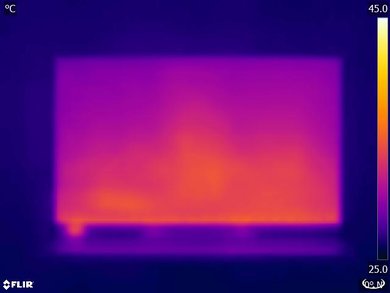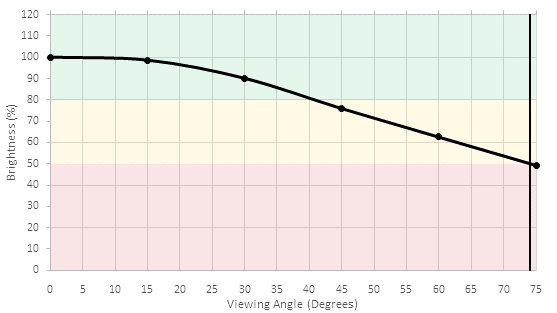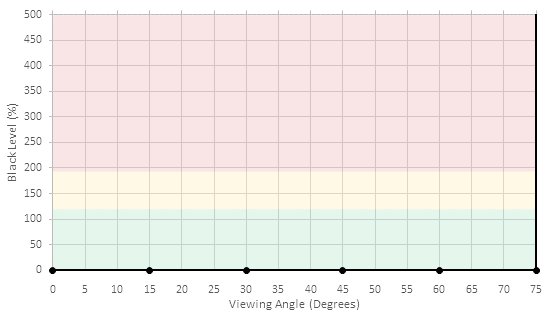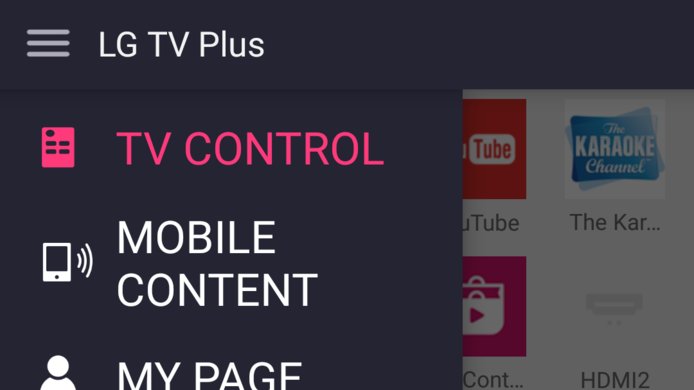The LG E7 OLED is a great 4k smart TV which features excellent picture quality and a well-rounded set of features that make it a versatile package. It has a dedicated soundbar for better audio capabilities, and its low motion blur and wide viewing angle help make it fit in both a dark home theater as well as a wide living room. Unfortunately, though, it suffers from temporary image retention, and it isn't quite as bright as its LED counterparts.
Our Verdict
Great TV for a mixed usage. The LG E7P OLED TV offers excellent picture quality in almost every environment, and its versatile set of features make it fit with just about any usage. It's not quite as bright as some LED TVs, but it isn't an issue in most cases.
-
Exceptional picture quality thanks to perfect blacks
-
Low input lag for gaming
-
Excellent viewing angle makes it suitable for wide rooms
-
Static content is temporarily retained on screen
Exceptional TV for watching movies in a dark room. Thanks to the E7's OLED technology, individual pixels can be shut off completely, giving it an infinite contrast ratio. Content played back on the E7 shows an impressive amount of depth, and no blooming or uniformity issues are seen in black letterboxes.
The LG E7P does a great job with TV shows. Thanks to its excellent screen finish which handles reflections much better than average, it has no issues being viewed in a room with a lot of windows. Combined with its very wide viewing angle, it makes for an excellent daytime watching experience.
Very good TV for watching sports. The LG E7P's OLED display produces virtually no motion blur, which means that very fast content such as sports look exceptionally fluid and crisp. It also produces a very uniform image, so green football fields are completely free of blotches and other anomalies.
Great gaming TV. The LG E7's low input lag and great handling of motion make it one of the best gaming TVs around. Games feel responsive, its excellent picture quality helps make the experience very immersive.
Excellent choice for HDR movies. The E7P's exceptional picture quality gets even better with HDR content thanks to its very wide color gamut and great handling of gradients. HDR content is vibrant and shows an impressive amount of detail.
Great HDR gaming TV. The LG E7 has no issues translating its gaming performance with HDR games, as its input lag is not impacted by the signal.
Great PC monitor. The LG E7's low motion blur and input lag make for a natural experience, and it is even capable of supporting fancier resolution such as 1080p @ 120 Hz. Unfortunately, it also suffers from temporary image retention which can be an issue with the very static content often seen with PC use.
- 8.7 Mixed Usage
- 9.3 Movies
- 8.4 TV Shows
- 8.4 Sports
- 8.7 Video Games
- 9.1 HDR Movies
- 8.6 HDR Gaming
- 8.1 PC Monitor
Changelog
- Updated Mar 12, 2018: Converted to Test Bench 1.2.
- Updated Nov 10, 2017: LG's new Active HDR feature (Dynamic Contrast: Low) improves the EOTF considerably, so we recommend enabling it. Unfortunately Active HDR doesn't work in Game or PC mode.
- Updated Oct 23, 2017: Sound has been re-tested using the TV's different room correction settings.
- Updated Oct 10, 2017: Review published.
- Updated Oct 08, 2017: Our testers have started testing this product.
Check Price
Differences Between Sizes And Variants
We tested the 55" (OLED55E7P). For the most part, we expect our review to be valid for the 65" (OLED65E7P).
If someone comes across a different type of panel or if their LG OLED 55E7P doesn't correspond to our review, let us know and we will update the review.
| Size | Model |
| 55" | OLED55E7P |
| 65" | OLED65E7P |
Compared To Other TVs
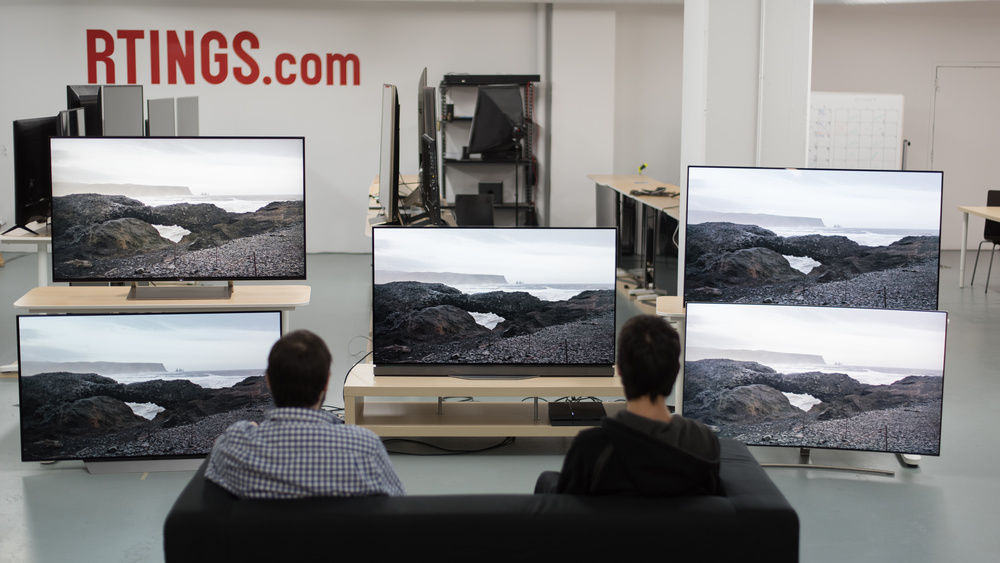
The LG E7P is an excellent 4K TV, but its premium pricing makes it hard to recommend over LED TVs from competing brands as well as cheaper LG OLEDs.
The LG E7P has a very similar performance to the LG C7. They have very similar scores in all our tests, and the main difference is the presence of a dedicated soundbar on the E7P. Also, the performance of our temporary image retention test was slightly better on the E7P, but this can be attributed to panel variance.
The LG C8 OLED is slightly better than the LG E7 OLED. The LG C8 has a black frame insertion (BFI) feature that can help clear up blur in fast-moving content. Also, the LG C8 can get brighter, which matters if you watch a lot of TV shows in a bright room. On the other hand, the LG E7 has a dedicated soundbar and somewhat better input lag when playing HDR games and can remove 24p judder from any source.
The LG E7 has a very similar performance to the LG B7A. The two TVs score almost the same in most of our tests. The main difference is the presence of a dedicated soundbar found on the E7 to improve sound performance and the temporary image retention, where the E7 is doing better, but this can be attributed to panel variance.
The LG E8 is slightly better than the LG E7P. The LG E8 has an optional black frame insertion feature that helps remove motion blur and make the image look crisper. The LG E8 also has better out of the box color accuracy so that you can enjoy great picture quality in movies without the need for a professional calibration.
The LG B8 is marginally better than the LG E7P. The LG B8 supports a black frame insertion (BFI) feature that can make fast content crisper. On the other hand, the LG E7P has a dedicated soundbar and a better input lag when playing HDR games.
Test Results
The design of the LG E7 is excellent. It looks sleek from any angle, and will certainly stand out in a room. The edges of the TV are glass, and the soundbar acts as a stand to support the TV very well. It can be a little bit difficult to move due to how thin the screen is, but for most people, this is a single event.
The build quality of the E7P is excellent, and the whole TV feels very premium. The textured back is a nice touch, as is the 'Picture on glass'. Even the remote feels higher quality (but bigger) than other LG models.
The LG E7P has an outstanding contrast ratio since, like other OLED TVs, when the TV is displaying a totally black color, the TV does not emit any light at all. This makes the E7P a perfect TV for a dark room. Blacks are deep and dark scenes look fantastic.
The LG E7P does not need any local dimming because OLED is an emissive technology, so when the TV displays a pure black it totally shuts down the emissive part in that region, so no blooming or clouding is created.
Good SDR peak brightness. The TV's Automatic Brightness Limiter (ABL) doesn't kick in during our 50% and smaller white window tests, so the TV's brightness will only decrease during very bright scenes, or during PC monitor use with white web pages. However, when the brightness does decrease it does so drastically and it's very visible. Overall the TV is bright enough for a bright room, but may be a little dim in a very bright room.
The brightness is a little less than the LG C7 OLED, which uses the same panel, but the difference is within expected panel variance from unit to unit. However, many other competing LED TVs are much brighter, such as the Sony X930E, X900E, Samsung MU8000 and Q9F.
Good HDR peak brightness. Though the TV's ABL limits its brightness quite severely when very bright content is shown, these kinds of bright scenes are very rare for HDR content because it's usually mastered for an average scene brightness of 100 cd/m². Our real scene test shows that highlights in a typical scene can reach a very good 689 cd/m², though still quite short of the 1000-4000 cd/m² HDR highlights are typically mastered for.
Overall the brightness is a little less than the LG C7 which uses the same OLED panel, but the difference is within panel variance from unit to unit so both can be considered equal. The E7P fares better against its LED TV kin in HDR than in SDR, but a few LED TVs are still brighter such as the Sony X930E, X900E and Samsung Q9F.
Great gray uniformity for the E7P and this is almost the same result as we have measured on the C7 OLED. On our 50% gray test picture, besides a warmer patch near the bottom, not much uniformity issues can be noticed. Dirty screen effect is not a problem at all here and we did not notice it at all while watching sports like hockey or football.
Looking at our 5% gray uniformity test picture, some vertical lines can be noticed (looks at the picture with the light closed to see the issues better) but in person, those lines are only visible while displaying a dark uniform color and not really problematic while watching normal video content.
Great viewing angle, as expected from an OLED TV. Blacks remain perfect at an angle and brightness decreases gradually, however, color shift becomes severe when viewed at moderate angles. Overall this TV is a great choice for a room where people often view the TV from the side.
The reflection handling of the E7 is excellent. It has a glossy finish so reflections are defined, but reduced in intensity significantly. It has a purple tint similar to other high-end TVs such as the C7 and Q9F, but this results in excellent performance even in a bright room.
Out of the box and with the picture mode that brought us the closest to our calibration target, the accuracy is average. This is mostly due because the E7P gamma is tracking closer to the 2.4 target and thus, the white balance accuracy is also affected. The C7 gamma target, with the same 'Out of the box' setting, was tracking closer to the 2.0. This may be only due to panel variance and is not really a problem in itself. The color accuracy is a bit high, but can mainly be explained by the drift of the white point toward the yellow, which all other colors also have from their respective targets.
After calibration, most of the issue encountered at the pre-calibration step are fixed, and the final result is an extremely accurate TV with a white balance dE of only 0.13, which is unnoticeable. The white balance control was extremely precise, and corrections were easy applied. The gamma curve is very flat and tracking very closely our 2.2 target.
The color dE was brought down to 0.99, which again is almost unnoticeable by anyone. The white point target now tracks very precisely. The color management system was helpful, but it is still not as precise and easy to use as other available color management system of other brands.
You can see our recommended settings here.
Excellent wide color gamut. In DCI P3 all three red, green and blue primaries are close to their targets, and in Rec 2020 only green is far from its target, as is common for modern TVs. This gamut is very similar to the LG C7, B6 and other OLEDs from last year, but not quite as good as Samsung's 2017 QLED TVs like the Q7F.
The TV's EOTF in the HDR Cinema Home picture mode undershoots the PQ curve quite a bit, making most scenes more dim than intended. The EOTFs in Game and PC modes are similarly dim. The picture quality still looks very good in a dark room because of the TV's infinite contrast ratio, but in a bright room HDR content will look too dim. Setting 'Dynamic Contrast' to Medium or High can alleviate this somewhat, at the cost of less accurate picture quality.
Update 11/10/2017: LG's new Active HDR feature (Dynamic Contrast: Low) improves the EOTF considerably, so we recommend enabling it. Unfortunately Active HDR doesn't work in Game or PC mode.
Decent color volume. The TV's infinite contrast ratio helps it extend its wide color gamut to extremely low brightnesses, but at high brightness the TV's RGBW pixel structure prevents it from making saturated colors nearly as bright as it can make pure white. This color volume is a little different than that of the LG C7, but the difference is within expected panel variance from unit to unit so both can be considered equal.
The E7P has a great result on our gradient test. It can display our gradient test image very good and without any visible 8-bit banding, which is great for HDR content. Like the C7, light shade is almost spotless with only some little color issues in the darker color and grayscale. Banding in movies is not really more a problem here than on the C7.
Update 2017-11-07: Note that when the TV is set to 'PC' mode, via the input menu, the banding is much more visible, and this for all picture modes.
The LG E7P did show some image retention on our image retention test but unlike the 2016 LG OLED TVs, it's far better and is very similar to the LG C7. The retention is not very strong right after the 10 minutes burn-in scene (as seen in the above picture) and after 4 minutes, it is almost not noticeable. After 6 minutes no retention is visible and this, when compared to the 2016 OLED TVs, is a big improvement.
Note that this test only tests the short term image retention and not the permanent burn-in that may occur with a longer exposition to static images. We are currently running a burn-in test that should give us clue on how each type of TVs respond to a longer exposure to static image and you can read more on this test here.
Note that there is a variation in temporary image retention between units.
OLED panels such as the E7 do have the possibility of experiencing burn in. You can see our investigation into this here.
Like other OLED TVs, the LG E7P has a nearly perfect response time, resulting in almost no visible blur following moving objects, which is excellent when watching fast-paced content. The downside of this is that low fame rate content such as movies may appear to stutter, because there is no motion blur to smooth transitions between frames.
Like all OLED TVs, the E7P doesn't flicker to dim, and instead shows each image for a full frame. Some flicker is detectable in our measurements but shouldn't be visible during normal usage. The absence of visible flicker makes motion appear slightly smoother, but results in some persistence blur.
Like with other 2017 LG OLEDs, it is unfortunately not possible to use Black Frame Insertion (BFI) to add flicker to help reduce persistence blur, like the Sony A1E does.
The LG E7P has a 120 Hz panel and can interpolate lower frame rate content to 120 fps, which greatly improves motion. Unfortunately the interpolation isn't as good as on some other TVs: the motion stuttered at times during normal content, especially cartoons, and artifacts would appear in rare cases. This behavior is similar to the LG C7. To enable motion interpolation (soap opera effect) set 'TruMotion' to 'User'. To interpolate a 30fps source increase 'De-Judder', and to interpolate 60fps content increase 'De-Blur'.
Update 11/13/2017: The motion interpolation performance has been clarified in the text.
Like other OLED TVs, the E7P has stutter which is especially noticeable with low frame rate content such as movies. This is a result of the very fast response time, so each frame is shown as a static image for some time. Unfortunately there is no way to fix this without adding additional frames through motion interpolation (the soap opera effect).
The E7 OLED is able to play 24Hz movies from any source (Blu-rays, DVDs and HTPCs) without judder. For 24p sources turn on 'Real Cinema' and set 'TruMotion' to cinema with both sliders set to 0, and this won't add the soap opera effect. For a 60p/60i source such as HTPC or cable box, only turning on the 'Real Cinema option is necessary.
The E7 has a native 120Hz panel, but doesn't support any variable refresh rate features.
Excellent low input lag, which should please all but the most competitive gamers. Both Game mode and PC mode have low input lag; all picture modes in PC mode have the same low input lag. 4:4:4 color is only shown properly in PC mode (aka when the input's icon is set to 'PC'). Overall the input lag is similar to the LG C7 and most Samsung TVs, and far better than most Sony TVs, but a little worse than the LG SJ8500 and TCL P607.
All common resolutions are supported. 4k @ 60 Hz @ 4:4:4 or 4:2:2 colors are only supported when 'HDMI ULTRA HD Deep Color' is enabled for the port being used. 4:4:4 color is only shown properly when the input's icon is set to 'PC' (aka PC mode). 1080p @ 120 Hz is listed as a possible resolution in the TV's EDID, so no custom resolution is required.
Good frequency response, the LG E7P follows our target decently well and it extends well into lower frequencies. It also doesn't have much dynamic range compression at higher volumes, so the sound quality doesn't deteriorate when brought up to its maximum.
Average Distortion performance. The E7's THD follows a common pattern where levels are relatively low at normal listening volumes but rise significantly higher the volume is brought up. IMD is also quite high when the TV's volume level is set to max.
The webOS interface is split into three sections: apps, settings, and inputs. Each section has its own button on the remote, quick menu and full menu. This makes navigating the interface very quick when you know what you're looking for, but the split nature may be confusing to first-time users.
Out of the box, the TV has many popular apps preinstalled such as Netflix and Amazon Video. The LG Content Store has many more apps available for download, more than most other app stores but not quite as many as the Samsung or Google Play app stores on other TVs. Apps launch fairly quickly and run smoothly.
The E7P's remote has almost the same button configuration as the C7 and SJ8500's smart remote, but with a much longer and thinner body. The remote is very large and has appreciable weight, but it offers a few great smart features in return. The highlight of the remote is the pointer: when the remote is pointed at the TV a cursor on the TV follows its movement, allowing menu items to be selected directly and avoiding clicking through the rest of the menu. The select button on the remote also doubles as a scroll wheel, also speeding up menu interaction. The remote has a microphone for voice search, which mostly just searches for content from sources like YouTube and Netflix, but it can also be used to quickly launch apps and inputs.
The LG TV Plus app offers a few useful features like streaming files from the device running the app, but lacks some features found on other apps, like text entry.
Comments
LG E7 OLED: Main Discussion
Let us know why you want us to review the product here, or encourage others to vote for this product.






